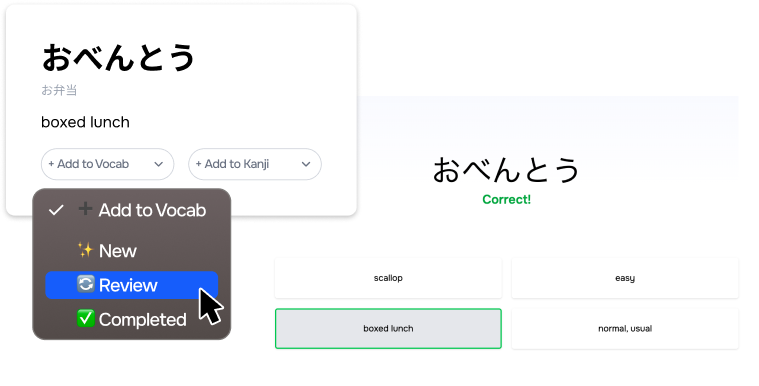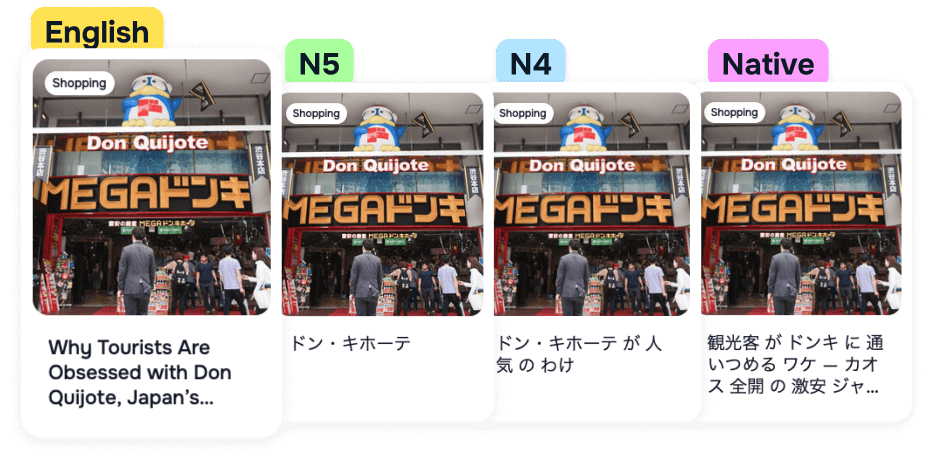Learn Japanese from Zero: The Ultimate Guide for Beginners
Learning Japanese might feel like an impossible mountain to climb, but it doesn’t have to be. Whether you’re dreaming of traveling through Tokyo, enjoying anime without subtitles, advancing your career, or connecting more deeply with Japanese culture, we'll guide you step by step to learn Japanese!
Our approach is to learn enough basics to thrust yourself into immersive Japanese content. This is how kids learn, and it's probably the most fun (vs rote memorization of words you don't care about - are you ready to read some weird internet stuff instead? 😏).
Step 1: Japanese Writing Systems
Start by learning the Hiragana, Katakana, and Kanji writing systems. You don't really need kanji to start reading very basic things, like some of our graded readers. Once you get the hang of the basic kana, you can work on improving your pronunciation.
あ い う え お か き く け こ
Learn the 46 basic hiragana characters and various combinations to start.
ア イ ウ エ オ カ キ ク ケ コ
Move onto katakana for foreign loanwords, names, and modern Japanese expressions.
日 一 人 大 本
Start learning essential kanji with meanings, readings, and real-world examples.
Which should you learn first?
If you're new to Japanese, start with hiragana to learn the basic sounds. Then move on to katakana for foreign words and names. Kanji can be introduced gradually alongside vocabulary so you can read menus, signs, and everyday Japanese.
Kanji is often the hardest part of Japanese, and you don't necessarily know how to speak Japanese just because you know a handful of kanji! You can pace it the same way as a Japanese schoolkid would, and learn them in context.
Step 2: Learn Japanese Grammar
Our grammar lessons cover everything from basic sentence structure to advanced patterns, with explanations and examples designed for learners at every level. We're always adding new content - stay tuned for more advanced lessons!
No grammar lessons found.
Step 3: Build Vocabulary & Start Reading!
After mastering kana, it’s time to grow your vocabulary. The easiest way to start is with simple, context-based reading. Our L0 graded readers introduce beginner-friendly words through short, fun stories. By seeing new vocabulary in action, you’ll naturally build confidence and reading skills.
Save Vocabulary in Your Bento Collections
Did you know you can save articles, readers, and words to your Collections in your Bento Japanese account? You can create a free account and start saving up the words you're curious about, and practice vocabulary!

Step 4: Leveling Up to Intermediate Japanese
Once you’re comfortable with the basics, it’s time to challenge yourself with more variety. Our blog is full of articles on Japanese culture, travel, and study tips, giving you natural exposure to everyday language. Pair that with our L1+ graded readers, which add new grammar and vocabulary based on the topic you read.
Read Articles at Your Level
Every article on our blog can be adjusted to match your current JLPT level — from N5 beginners up to native-level content. This means you can read about Japanese culture, travel, and daily life in a way that’s challenging but never overwhelming. Switch levels anytime and grow your skills step by step. You can come back to the same article and try to read it at a higher level too. You'll see just how far you've come, because you'll be able to read more difficult Japanese!

Step 5: Reaching Native or Near-Native Japanese
At this stage, you can push yourself beyond JLPT study and into the world of authentic Japanese. Keep challenging yourself with harder kanji — even those that go beyond the typical 常用漢字 most adults use — and dive deeper into natural, nuanced expressions. This is where Japanese really opens up: novels, essays, opinion pieces, comedy writing, and the “fun stuff” people read every day. Our blog is written to be interesting even for native speakers, so you can practice with real content that feels authentic.
Take the JLPT
For many learners, passing the JLPT (Japanese Language Proficiency Test) is a ticket to new opportunities in Japan. Most employers look for at least an N2 level, which shows you can handle everyday communication and workplace Japanese. Once you reach this stage, you can realistically consider moving to Japan for work or study. Check out our guide on how to get a job in Japan, and practice with our graded reader on part-time job interviews to get a feel for real-world Japanese you’ll need on the job hunt.
Aim for Kanji Mastery
For advanced learners, kanji study doesn’t stop at JLPT N1. Many take on the 日本漢字能力検定 (Kanken), a test designed for native speakers that covers rare and advanced characters. Working toward Kanken levels is a great way to strengthen your reading and writing, push beyond 常用漢字, and gain a deeper appreciation of Japanese literature and media. Even if you never sit the exam, following its kanji lists gives you a roadmap to native-level literacy. You can collect kanji from Bento content in the Collections feature and practice as well.
